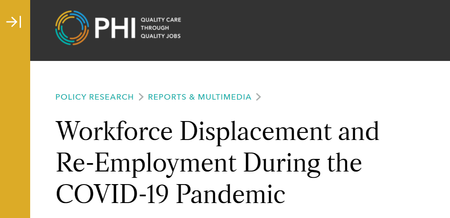PHI Report: Workforce Displacement and Re-Employment During the COVID-19 Pandemic - Implications for Direct Care Workforce Recruitment and Retention

PHI and the Health Workforce Research Center on Long-Term Care at the University of California, San Francisco have released a report, "Workforce Displacement and Re-Employment During the COVID-19 Pandemic: Implications for Direct Care Workforce Recruitment and Retention."
The report examines workforce displacement and re-entry during the COVID-19 pandemic among direct care workers and workers from similar entry-level occupations, in order to understand whether and how new workers were recruited into direct care jobs during this crisis, which has implications for the long-term care field. The report found that, during the first three months of the COVID-19 pandemic in 2020, 13.7 million workers were displaced from occupations with similar entry-level requirements to direct care. One year later, 66% of those displaced workers had re-entered the workforce. Across demographic groups, women and people of color were more likely to be displaced and less likely to re-enter the workforce, as well as displaced workers with caregiving responsibilities.
Analysis showed that large-scale movement of displaced workers into direct care jobs has not occurred. The report suggests several opportunities to strengthen the direct care workforce and "underscores the urgent need to build robust recruitment pipelines into the longterm care field and to make meaningful, lasting improvements in job quality for direct care workers."
To learn more and to read the report, click here.
To go to the press release, click here.
To learn about JAHF's support of PHI, click here.
